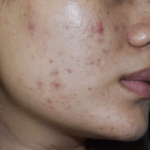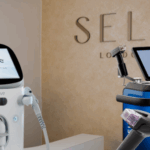
Weight loss should make you look and feel better. For many patients, it does: appetite is calmer, clothes fit, health improves, and movement becomes easier. Yet another change often appears. Strength feels different, posture softens, the abdomen does not hold, and the skin seems to drape differently. This is not failure. It is the signature of muscle loss during weight reduction, often invisible on the scales but obvious in the mirror and daily life.
Why preserving muscle matters
Muscle is the body’s most powerful anti-ageing system. It drives energy expenditure, supports joints and spine, disposes of glucose, and provides the foundation that allows skin to sit naturally. When you preserve muscle as you lose fat, you keep definition, you protect posture, and you make results durable. When you lose both fat and muscle, you look lighter but feel older.
At Self London, we use Pure Impact EMS to protect and rebuild muscle during weight loss, so the result is not only a smaller number on the scales but a stronger body that holds its shape.
Why muscle loss happens during weight loss and GLP-1 therapy
All effective weight-loss methods reduce energy availability. This lowers anabolic signalling, alters protein turnover, and reduces the intensity of training that can be sustained. As a result, lean muscle mass is often lost alongside fat.
Pharmacological therapies such as semaglutide (GLP-1 receptor agonists) produce substantial fat loss but also reduce absolute lean mass. While the ratio of lean muscle to fat may improve, absolute lean tissue is what determines strength, posture and how skin drapes.
Training quality also changes during weight reduction. Energy is lower, recovery is slower, and protein intake often falls. The body conserves energy by allowing muscle fibres to atrophy unless given a structured stimulus to retain them.
The solution is not to avoid GLP-1 therapy; it is to pair it with a muscle plan. Keeping contractile tissue during fat loss ensures the silhouette looks defined, not depleted. That is the gap Pure Impact EMS is built to close.
The physiology of muscle loss and its aesthetic impact
Skeletal muscle is a metabolically expensive tissue. In a calorie deficit, the body conserves energy by reducing protein synthesis and increasing protein breakdown. Hormonal shifts reinforce this process. Fast-twitch fibres, responsible for definition and explosive power, are particularly vulnerable.
The result is not just a loss of strength but of structure. As the abdominal wall thins, the gluteals weaken and the thighs reduce, the frame softens, and the skin appears looser. What patients often interpret as skin ageing is the loss of muscle scaffolding beneath.
Posture, coordination and recruitment patterns also change. Movements feel less crisp, bracing becomes harder, and clothes sit differently. Skin treatments such as Sofwave, UltraClear, BBL and HALO all deliver better results when muscle is preserved.
What Pure Impact EMS does differently
Electromagnetic muscle stimulation (EMS) delivers external signals that depolarise motor nerves and trigger contractions. Unlike voluntary training, EMS reliably recruits high-threshold fast-twitch fibres that define shape and control posture.
This is not a replacement for training but a neuromuscular intervention that complements it, especially during calorie deficit, perimenopause, recovery from injury, or busy periods.
Clinical studies confirm EMS improves strength within weeks. Meta-analyses show it can match conventional strength training when volume is equal, and even enhance outcomes when combined with exercise. Whole-body EMS has been shown to increase muscle mass, power and function in adults, including after midlife.
With Pure Impact EMS, patients notice differences that voluntary training cannot always achieve during weight loss:
- Deep contractions even when fatigued
- High-threshold fibre recruitment preserved
- Meaningful training stimulus without joint strain
Can EMS prevent muscle loss during weight loss?
Yes. EMS preserves recruitment and contractile function when energy and recovery are limited. It delivers the consistent signal the body needs to retain muscle, even when voluntary training dips.
If you keep asking a muscle to work, the body keeps it. If you stop, it lets it go. EMS ensures the stimulus is delivered consistently, protecting shape and function during 12-16 weeks of weight loss.
What a Pure Impact EMS session feels like
Pure impact EMS sessions target abdominals, obliques, gluteals and thighs – the areas that define posture and silhouette. Patients feel rhythmic, deep contractions, stronger than most can achieve voluntarily during a calorie deficit.
Within weeks, the abdomen holds without effort, the ribcage stacks over the pelvis, the glutes contribute properly, and posture feels lighter and more efficient. Clothes skim more naturally, and fatigue arrives later.
Because EMS runs at a set intensity, motivation is no longer a barrier. Sessions provide consistent, high-quality work even during low-energy phases of GLP-1 therapy.
How Pure Impact EMS fits into weight-loss programmes
During active weight loss, especially with GLP-1 therapy, we begin Pure Impact early. Preserving tissue is easier than rebuilding it later. Appetite control aids fat loss but can reduce protein intake; EMS gives muscle a reason to stay.
After weight stabilises, the programme consolidates gains. Abdominals are strengthened, gluteal output restored, and lower-body recruitment fine-tuned. Programmes are tailored to exercise habits, recovery and goals, complementing or substituting resistance training as needed.
Results patients notice
- Improved abdominal hold and posture within 2-3 weeks
- Firmer silhouette with clearer hip and rib lines
- Reduced lower back tension and easier stair climbing
- Fat loss on the scale, with visible strength in the mirror
These changes also enhance skin treatments, making tightening, contouring or resurfacing appear more natural.
Who benefits most from Pure Impact EMS?
- Patients losing weight on GLP-1 medication
- Women in perimenopause and post-menopause
- Those returning from injury or rest periods
- Patients with limited training time or energy
The common factor is that Pure Impact fills recruitment gaps, preserving muscle structure during change.
Frequently asked questions about EMS and weight loss
Can EMS stop muscle loss on semaglutide?
Yes. EMS improves strength and preserves contractile function when voluntary training is reduced.
Is EMS a substitute for strength training?
No. EMS is not a substitute for strength training. Resistance training remains essential, but EMS complements it, adding stimulus during calorie deficit and recruiting fibres that conventional training sometimes misses.
Is EMS safe?
Yes. EMS is safe when supervised. Proper screening excludes contraindications such as implanted devices or relevant cardiac and neurological conditions. Trials show good tolerance and functional gains in adults, including older patients.
How soon will I notice changes?
Many patients notice improvements in abdominal hold, posture and stair performance within 2-3 weeks. Visible lift and definition follow as recruitment improves.
Why does method matter more than machine?
Results depend on expert application, not hardware alone. At our medical dermatology clinic on Harley Street, Pure Impact protocols are designed and overseen by clinicians who integrate them into wider care for sustainable results.
Book your consultation at Self London
Pure Impact EMS is not about appearance alone; it is about structure, capacity, and confidence during weight loss. At Self London, we use EMS to protect muscle while reducing fat, ensuring stronger results, not just a lower number on the scales.
Book your consultation today at our clinic on Harley Street and discover how Pure Impact EMS can help you achieve fat loss without sacrificing strength.





